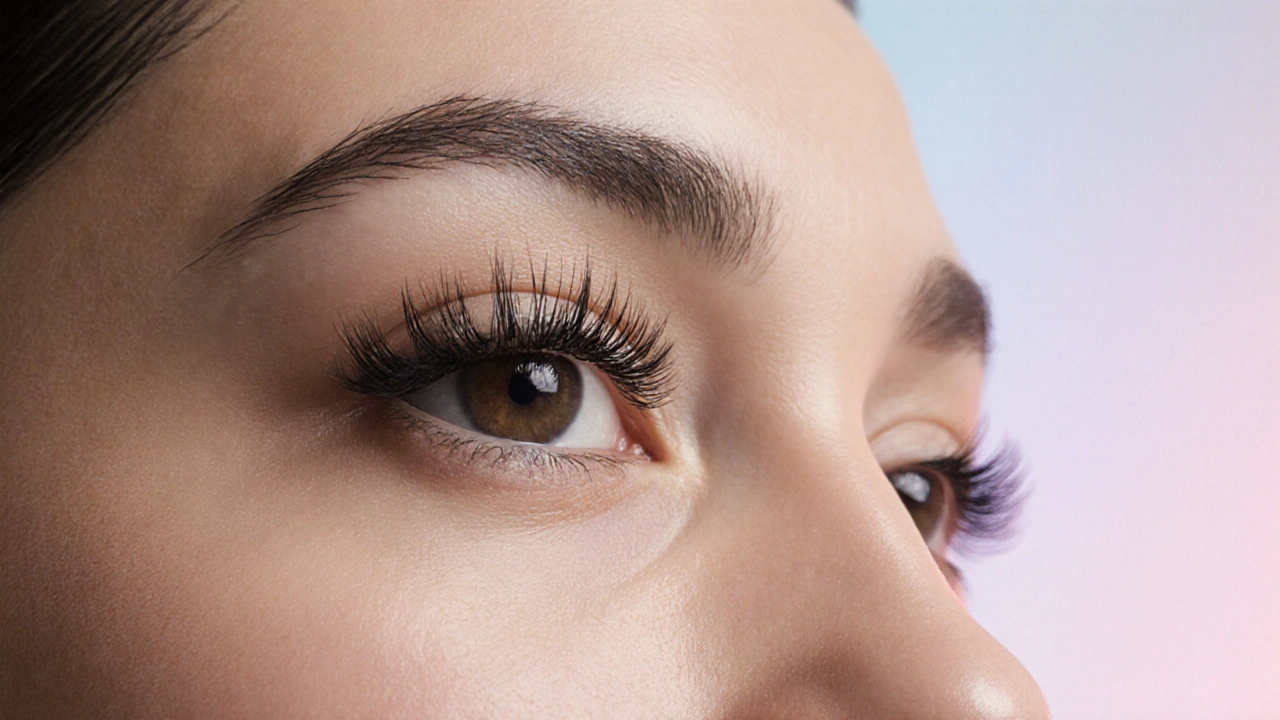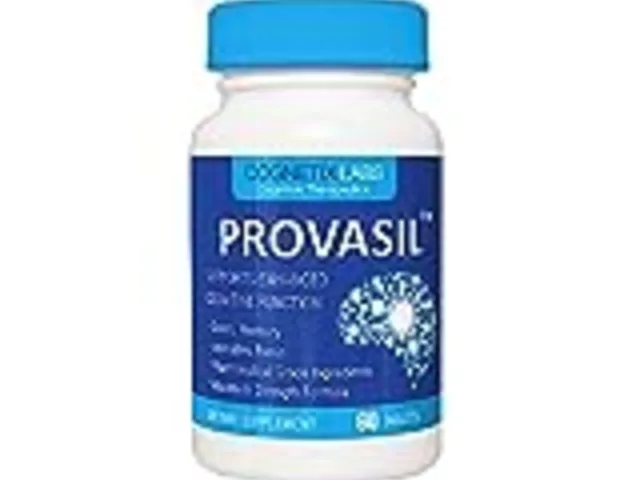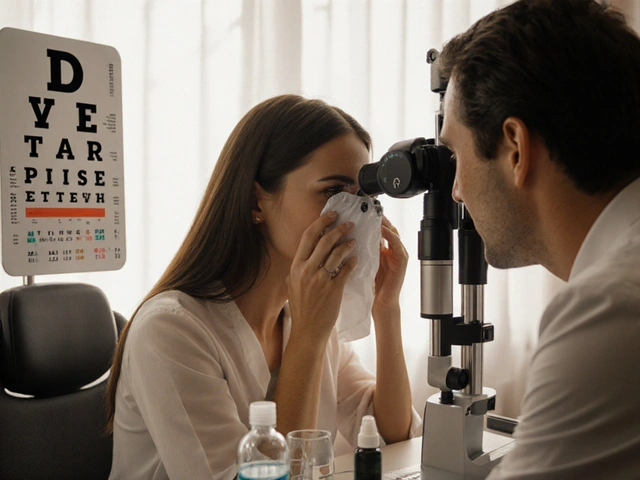Glaucoma & Eyelash Treatment Comparison Tool
Select a treatment to compare its efficacy and side effects:
When you hear the name Bimatoprost, you probably think of longer lashes or lower eye pressure. But is it really the best pick for you? Below is a quick snapshot of what you need to know before deciding.
- Understand how Bimatoprost works and where it shines.
- Explore the most common alternatives and how they differ.
- See a side‑by‑side table of efficacy, dosing, and side‑effects.
- Learn which factors should guide your personal choice.
- Get answers to the top questions patients ask.
What is Bimatoprost?
Bimatoprost is a synthetic prostaglandin analog originally developed to lower intra‑ocular pressure in glaucoma patients. Marketed under the brand name Bimat, it was later repurposed as a cosmetic eye‑drop for enhancing eyelash length, thickness, and darkness.
Its dual action comes from stimulating the prostaglandin F (FP) receptors in the eye, which improves outflow of aqueous humor and also prolongs the anagen (growth) phase of eyelash follicles.
How Bimatoprost Works
Once you instill a single drop, the drug binds to FP receptors on the trabecular meshwork. This triggers remodeling of the extracellular matrix, allowing fluid to drain more efficiently. The result: a typical 20‑30% drop in intra‑ocular pressure (IOP) within a few hours.
For eyelashes, the same receptor activation nudges the hair cycle to stay in the growth phase longer. Clinical trials reported an average 2‑3mm increase in lash length after 12 weeks of nightly use.
Key Benefits of Bimatoprost
- Proven IOP reduction: Consistently hits the 20‑30% range, comparable to other prostaglandin analogs.
- Effective cosmetic result: Most users see noticeable lash changes within two months.
- Convenient dosing: One drop at night, no need for multiple daily doses.
- Long‑term data: Over a decade of use in glaucoma therapy provides safety confidence.
Common Alternatives
While Bimatoprost is popular, several other agents compete for the same therapeutic space. Below are the most frequently prescribed options.
Latanoprost is another prostaglandin analog that primarily targets FP receptors, offering similar IOP reduction but a slightly milder pigment‑darkening effect on lashes.
Travoprost shares the FP‑receptor pathway but is packaged with a preservative‑free formulation for patients sensitive to benzalkonium chloride.
Tafluprost is a newer prostaglandin analog, marketed as preservative‑free and designed for patients with ocular surface disease.
Timolol belongs to the beta‑blocker class; it lowers IOP by reducing aqueous humor production rather than improving outflow.
Brimonidine is an alpha‑2 agonist that both decreases production and modestly increases outflow, often combined with other drops for maximal effect.
Each drug has its own strengths, drawbacks, and ideal patient profile.

Side‑Effect Profile at a Glance
Understanding the safety landscape is crucial. Below is a concise look at the most reported adverse events for each medication.
| Drug | Common Ocular Side‑effects | Systemic Concerns | Special Warnings |
|---|---|---|---|
| Bimatoprost | Hyperpigmentation of iris, peri‑ocular skin darkening, mild eye irritation | Rare systemic headache | Avoid in patients with active uveitis |
| Latanoprost | Less iris darkening, occasional eyelash growth, mild stinging | Negligible | Contra‑indicated in hypersensitivity |
| Travoprost | Similar to latanoprost, but preservative‑free reduces dry‑eye complaints | Negligible | Watch for allergic reactions to the vehicle |
| Timolol | Burning, transient blurred vision | Bradycardia, bronchospasm in asthmatics | Use with caution in COPD or heart block |
| Brimonidine | Conjunctival hyperemia, allergic reaction | Dry mouth, fatigue | Not for severe hepatic impairment |
Head‑to‑Head Efficacy Table
| Drug | Mechanism | Primary Indication | Typical IOP Reduction | Dosage Frequency |
|---|---|---|---|---|
| Bimatoprost | Prostaglandin F‑receptor agonist | Glaucoma & cosmetic eyelash growth | 20‑30% | Once nightly |
| Latanoprost | Prostaglandin F‑receptor agonist | Open‑angle glaucoma | 22‑28% | Once nightly |
| Travoprost | Prostaglandin F‑receptor agonist | Open‑angle glaucoma | 21‑29% | Once nightly |
| Timolol | Beta‑adrenergic blocker | Glaucoma (often combined) | 15‑25% | Twice daily |
| Brimonidine | Alpha‑2 adrenergic agonist | Glaucoma, ocular hypertension | 18‑23% | Twice daily |
How to Choose the Right Option for You
There isn’t a one‑size‑fits‑all answer. Consider the following decision points:
- Primary Goal: If you’re mainly after eyelash enhancement, Bimatoprost or Latanoprost are the only FDA‑approved options. For pure IOP control, any of the five agents work, but prostaglandin analogs usually win on efficacy.
- Eye‑Surface Health: Patients with dry‑eye or allergic conjunctivitis may prefer preservative‑free travoprost or tafluprost.
- Systemic Health: Those with asthma, COPD, or heart block should avoid beta‑blockers like timolol and consider prostaglandin analogs or brimonidine.
- Cost & Availability: Generic latanoprost is often cheaper than branded bimatoprost; insurance formularies can tip the scales.
- Side‑Effect Tolerance: If iris darkening bothers you, Latanoprost or Travoprost have milder pigment changes.
Practical Tips for Using Bimatoprost and Its Peers
- Administer the drop at the same time each night, preferably before bedtime.
- Pull down the lower eyelid gently to create a small pocket; avoid touching the tip to the eye.
- If you wear contact lenses, remove them first and re‑insert after the drop has absorbed (about 5‑10 minutes).
- Store the bottle in a cool, dry place; discard after 6 weeks of opening, even if fluid remains.
- Report any sudden eye pain, vision changes, or persistent redness to your ophthalmologist immediately.
Frequently Asked Questions
Can I use Bimatoprost for both glaucoma and eyelash growth at the same time?
Yes. The same drop that lowers intra‑ocular pressure also stimulates longer lashes. Most clinicians prescribe the same dose (0.03%) once nightly for both purposes, but you should discuss your cosmetic goals with your eye doctor to confirm the regimen.
How long does it take to see a noticeable change in lash length?
Most users report visible lengthening after 6‑8 weeks, with peak results around 12‑16 weeks. Patience is key; stopping the treatment will gradually return lashes to their baseline.
Is iris darkening permanent?
In most cases the brown or black pigmentation is permanent for the treated eye. If the change is cosmetically concerning, switching to latanoprost, which causes milder pigment shifts, may be advisable.
Can I combine Bimatoprost with another glaucoma drop?
Yes, many patients use a prostaglandin analog like Bimatoprost alongside a beta‑blocker or carbonic‑anhydrase inhibitor for additive IOP reduction. Always space drops by at least five minutes to prevent wash‑out.
What should I do if I experience severe eye irritation?
Stop the medication immediately and rinse the eye with sterile saline. Contact your eye care professional within 24 hours; they may recommend a preservative‑free formulation or an alternative class.
Choosing between Bimatoprost and its alternatives boils down to your primary objective, eye‑health profile, and tolerance for side‑effects. With a clear view of the pros and cons, you can have a confident conversation with your ophthalmologist and land on the option that fits your life best.



 Medications
Medications





Sue Ross
September 29, 2025 AT 20:18I appreciate how the table breaks down the IOP reduction percentages for each drug, it really helps to visualise the differences. The side‑effect column is especially useful for patients who are sensitive to pigment changes or ocular irritation. It’s also worth noting that preservative‑free formulations can make a big difference for people with dry‑eye issues. Overall, the comparison gives a solid starting point for a conversation with an ophthalmologist.
Rohinii Pradhan
September 29, 2025 AT 21:43The exposition provided herein exhibits commendable thoroughness, yet one must exercise caution when extrapolating these data to heterogeneous patient populations. While the efficacy ranges are statistically comparable, the lexical variation in ocular adverse events warrants meticulous patient counseling. Moreover, the nuanced distinction between iris hyperpigmentation and peri‑ocular skin darkening is often overlooked in lay discussions. Consequently, clinicians should tailor therapeutic selections to individual risk profiles rather than defaulting to the most popular agent.
Anna-Lisa Hagley
September 29, 2025 AT 23:06The mechanistic similarity among prostaglandin analogues invites a deeper philosophical reflection on the nature of therapeutic redundancy. One could argue that the market’s proliferation of near‑identical molecules reflects a capitalist compulsion rather than a genuine pharmacological need. Yet, the subtle variations in preservative content and pigmentary side‑effects do alter the lived experience of patients, suggesting that even marginal differences possess ethical weight. In this light, the choice of medication becomes a micro‑ethical decision embedded within broader systemic forces.
A Walton Smith
September 30, 2025 AT 00:30It's just another eye drop.
Theunis Oliphant
September 30, 2025 AT 01:53Behold the lamentable spectacle of modern ophthalmology, where profit‑driven formulations masquerade as miracles for lashes and pressure alike. One must question the moral compass of prescribing agents that permanently alter iris hue for cosmetic vanity. The righteous path lies in restraint, in choosing the least invasive therapy, and in demanding transparency from pharmaceutical titans.
Andrew Stevenson
September 30, 2025 AT 03:16Great overview! For anyone looking to optimise treatment, consider a combination regimen: a prostaglandin analogue for maximal outflow enhancement paired with a beta‑blocker to curb aqueous production. This dual‑mechanism approach often achieves target IOP with fewer drops overall. Also, preserve ocular surface health by selecting preservative‑free options when possible.
Poorni Joth
September 30, 2025 AT 04:40Honestly this whole hype around Bimatoprost is just another excuse for big pharma to cash in on vanity while pretending to save sight. People need to wake up and realise they are being sold a cosmetic lollipop with a side‑effect list that includes permanent iris darkening. If you care about your health, demand alternatives that don’t turn your eyes into a permanent eyeliner.
Suzette Muller
September 30, 2025 AT 06:03I hear your concerns and want to add that many patients report a smooth transition when switching to preservative‑free travoprost if irritation becomes an issue. It’s also helpful to schedule follow‑up appointments shortly after initiating therapy to monitor any pigment changes early. Open communication with your eye doctor can alleviate anxieties surrounding cosmetic side‑effects.
Josh SEBRING
September 30, 2025 AT 07:26Look, everyone’s treating these drops like they’re the holy grail, but honestly the real winner is just using whatever works without overthinking the branding hype.
Lily Tung
September 30, 2025 AT 08:50When assessing the comparative efficacy of prostaglandin analogues one must first acknowledge the inherent pharmacodynamic similarity that underpins their mechanism of action which is to augment uveoscleral outflow via FP‑receptor activation resulting in a measurable decrease in intra‑ocular pressure across the majority of clinical trials the reported reduction typically ranges between twenty to thirty percent which, while impressive, is not singular to any one compound the ancillary benefits such as eyelash elongation are a byproduct of the same receptor engagement and therefore are observed to varying degrees depending on individual follicular response an additional consideration is the pigmentary effect on the iris and peri‑ocular skin which, although reversible in some cases, can become permanent and thereby influence patient satisfaction further patient adherence is often contingent upon the tolerability of ocular surface irritation which may manifest as mild stinging or dryness especially in formulations containing benzalkonium chloride a preservative free alternative such as travoprost may mitigate these symptoms albeit at a potentially higher cost the systemic safety profile of prostaglandin analogues remains favorable with rare reports of headache or malaise unlike beta‑blocker therapy which carries risks of bradycardia and bronchospasm particularly in asthmatic individuals cost considerations cannot be ignored as generic latanoprost frequently offers a more economical option compared to branded bimatoprost nevertheless insurance formularies vary and patients should verify coverage prior to initiation for those with co‑existent ocular surface disease a preservative‑free formulation may be advisable the dosing schedule remains consistent across agents with once nightly administration being the standard which supports adherence due to its simplicity finally clinicians should tailor therapy based on a comprehensive evaluation of efficacy, side‑effect tolerance, systemic comorbidities and patient preference ensuring that the chosen agent aligns with the individual’s therapeutic goals and quality of life expectations.
Taryn Bader
September 30, 2025 AT 10:13Wow, the whole thing feels like a drama of chemicals battling for our eyes, and we’re just the audience watching the fallout.
Myra Aguirre
September 30, 2025 AT 11:36Sounds like a solid rundown, useful if you’re trying to decide which drop fits your routine.
Shawn Towner
September 30, 2025 AT 13:00While many herald these agents as breakthroughs, one might argue the incremental gains do not justify the cascade of side‑effects we routinely accept.
Ujjwal prakash
September 30, 2025 AT 14:23Honestly, the tables are great, they lay out the facts, and the reader can see, at a glance, which drug does what, which one’s cheaper, which one’s got the side‑effects that matter most, and you can decide, no need for a PhD in ophthalmology!